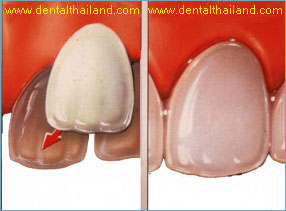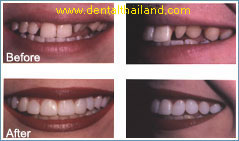Visit the details of our Empress Esthetic porcelain system 
 IPS Empress system IPS Empress system
 Empress Esthetics system Empress Esthetics system
Dental Veneers, instant orthodontic program "The Dental Extreme Makeover"
Dental veneers (sometimes called porcelain veneers or dental porcelain laminates) are wafer-thin, custom-made shells of tooth-colored materials designed to cover the front surface of teeth. These shells are bonded to the front of the teeth changing their color, shape, size or length and resulting in an improved appearance.
Dental veneers can be made from porcelain or from resin composite materials. Porcelain veneers resist stains better than resin veneers and better mimic the light reflecting properties of natural teeth. Resin veneers are thinner and require removal of less of the tooth surface before placement.
What Types of Problems Do Dental Veneers Fix?
Veneers are routinely used to fix:
- Teeth that are discolored ? Either because of root canal treatment; stains from tetracycline or other drugs, excessive fluoride or other causes; or the presence of large resin fillings that have discolored the tooth
- Teeth that are worn down
- Teeth that are chipped or broken
- Teeth that are misaligned, uneven, or irregularly shaped (for example, have craters or bulges in them)
- Teeth with gaps between them (to close the space between these teeth)
Veneers offer the following advantages:
- They provide a natural tooth appearance.
- Gum tissue tolerates porcelain well.
- Porcelain veneers are stain resistant.
- The color of a porcelain veneer can be selected such that it makes dark teeth appear whiter.
- Veneers offer a conservative approach to changing a tooth's color and shape - veneers generally don't require the extensive shaping prior to the procedure that crowns do, yet offer a stronger, more esthetic alternative to bonding.
Do Dental Veneers Require Special Care?
No. Continue to follow good oral hygiene practices including brushing and flossing as you normally would.
What's the Procedure for Getting a Porcelain Veneer?
The procedure usually requires two trips to the dentist? One for a consultation and two to make and apply the veneers. The procedure itself involves several steps. These are: diagnosis and treatment planning, preparation, and bonding. It is important to note that one tooth or many teeth can simultaneously undergo the veneering process described below.
- Diagnosis and treatment planning. This first step involves active participation between you and our cosmetic dentist. Explain to your dentist the result that you are trying to achieve. During this
appointment your dentist will examine your teeth to make sure dental veneers are appropriate for you and discuss what the procedure will involve and some of its limitations. We also may take x-rays and possibly make impressions of your mouth and teeth.
- Preparation. To prepare a tooth for a veneer, We will remove about 0.5-1.0 millimeter of enamel from the tooth surface, which is an amount nearly equal to the thickness of the veneer to be added to the tooth surface. Before trimming off the enamel, We will decide the need for a local anesthetic to numb the area. Next, We will make a model or impression of your teeth. This model is sent out to our in-house dental laboratory, which in turn constructs your veneer. It usually takes 5-7 days in this process. For very unsightly teeth, temporary dental veneers can be placed for no additional cost.
- Bonding. Before the dental veneer is permanently cemented to your tooth, we will temporarily place it on your tooth to examine its fit and color. We will repeatedly remove and trim the veneer as needed to achieve the proper fit; the veneer color can be adjusted with the shade of cement to be used. Next, to prepare your tooth to receive the veneer, your tooth will be cleaned and polished ? which roughens the tooth to allow for a strong bonding process. A special cement is applied to the veneer and the veneer is then placed on your tooth. Once properly position on the tooth, We will apply a special light beam to the dental veneer, which activates chemicals in the cement causing it to harden or cure very quickly. The final steps involve removing any excess cement, evaluating your bite and making any final adjustments in the veneer as necessary
 |
 |
Our Smile Makeover
"INSTANT ORTHO PROGRAM"
Case 1
Treatment
Working period
Cost
Date |
Smile Makeover
6 porcelain veneers
3 visits in 7 days
48,000 baht
(approx.US$1,200)
November 1st, 2004 |
 |
Case 2
Treatment
Working period
Cost
Date |
Crooked upper front teeth
10 porcelain veneers
3 visits in 10 days
80,000 baht (approx.US$2,000)
November 28th, 2004 |
 |
Case 3
Treatment
Working period
Cost
Date |
Short teeth
Laser Gum Surgery with 4 porcelain veneers
4 visits in 12 days.
36,000 baht (approx.US$900)
December 15th, 2004 |
 |
Case 4
Treatment
Working period
Cost
Date |
Smile Makeover
6 upper porcelain veneers with
4 upper porcelain crowns.
4 visits in 10 days.
88,000 baht (approx.US$2,200)
January 30th, 2005 |
 |
|